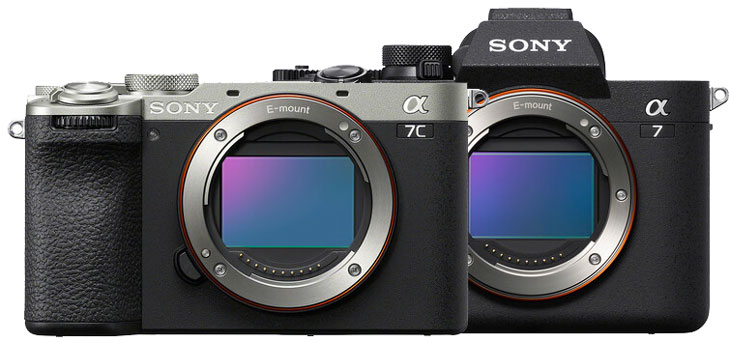
If you compare the Sony A74 versus the Sony A7C II, let me tell you one thing very clearly. The Sony A7C II camera features the same 33-megapixel full-frame CMOS sensor, Even the AF system of the Sony A7C II camera is much more advanced due to the presence of dedicated artificial intelligence CHIP inside, compared to the Sony A74 camera. Now, we all know that if a baseline product/product with a lower price range has as many special features as its higher-end body, then for sure it will cut off the sales of the A74.
To protect it, Sony added some layers of features and design cannibalization, which now depends upon us. Does this crippling hurt the camera’s core, or can we buy it despite the standard crippling done over Sony A7C II to save the Sony A7 IV sales? Which we will explain in this article.
| Lens Mount | Sony A7C II | Sony A7 IV |
| Sensor Resolution | Actual: 34.1 Megapixel Effective: 33 Megapixel |
Actual: 34.1 Megapixel Effective: 33 Megapixel |
| Image Sensor | 35.9 x 23.9 mm (Full-Frame) CMOS | 35.9 x 23.9 mm (Full-Frame) CMOS |
| Image Stabilization | Sensor-Shift, 7 Stops | Sensor-Shift, 5.5 Stops |
| Built-In ND Filter | None | None |
| Capture Type | Stills & Video | Stills & Video |
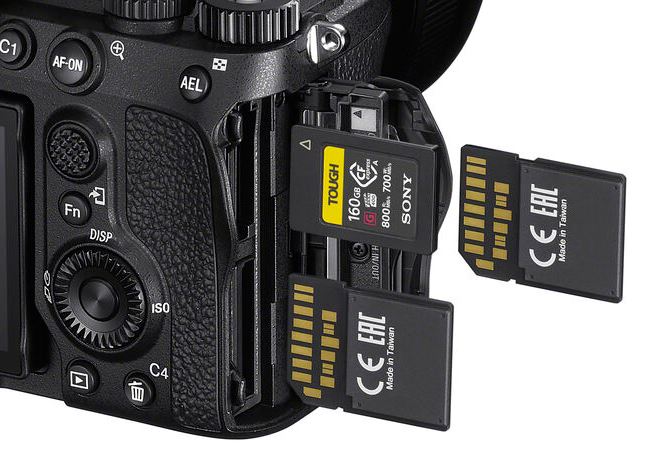
1. DUAL CARD SLOT
From the design point of view, there is a basic design difference between the two. The Sony A7C II camera has only a single card slot compatible with UHS-II V90 cards, while the Sony A7 IV camera features dual card slots in which you can have UHS-II and CFexpress in the other.
2. Full-size HDMI in Sony A7 IV
The other biggest advantage I see in the Sony A7 IV camera is the presence of a full-size HDMI port, which is missing in the Sony A7C II camera.
3. Anti-Dust Shutter in Sony A7IV
The Sony A7 IV camera also features an anti-dust settling mechanism that covers the sensor and protects it. In the Sony A7C II camera, we have an EFCS shutter, so due to the absence of a fully functional mechanical shutter, we do not have such a feature in this camera.
4. Display Difference
On the display side, the Sony A7 IV has a slightly higher resolution electronic viewfinder (3690k dotvs2360k dot) with a better magnification ratio, as well as a slightly higher resolution LCD screen (1.440k dots vs. 1.030k). The position of the viewfinder is also different in both cameras.
The rest of the things are the body controls. The Sony A7 IV camera has a bit more advanced features, such as a joystick controller on the rear side and a center-placed viewfinder, which generally helps a photographer a bit more in handling a camera and using it while composing a perfect shot
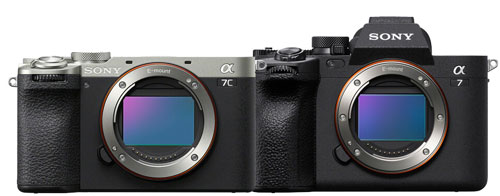
5. Size Difference
As you can see, the Sony A7C Mark II camera is more compact, whereas the A7 IV is a bit bulky. Due to the nature of construction and the type of series they belong to, both have their design interface. So, design-wise, for a professional photographer, undoubtedly the Sony A7 IV camera looks more promising.
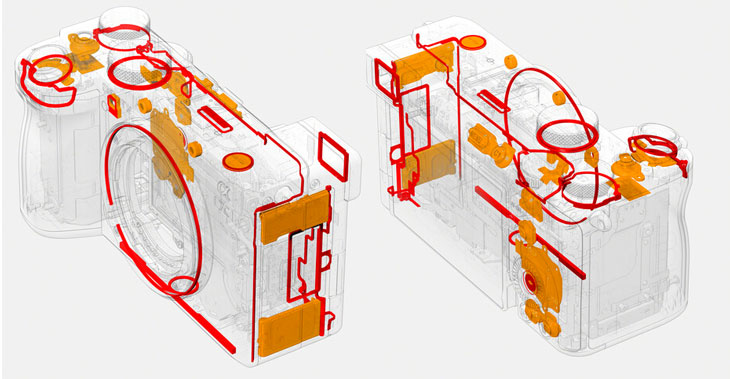
6. Heat Sink
Heat Sink According to initial reports, the heat sink mechanism of the Sony A7C Mark II camera is slightly better at dissipating heat from the body in an outward direction. This is one of the biggest reasons why Sony skipped the CF express card in the A7C Mark II camera. With the use of a UHS-II V90 card (See V90 Cards at Amazon), you can record 4K at all resolutions without any major issues.
Does The Absence Of Full Mechanical Shutter Affect The Performance Of The Camera? It all depends upon your usage. If you want to capture portraits at a very high shutter speed which is somewhere around 1/4000 of a second up to 1/8000 of a second in that very specific scenario most cameras with mechanical shutters are not open to some of these special situations then undoubtedly, the A7C Mark II camera’s EFCS (Electronic Front Curtain Shutter) is very usable.
| Sony A7C II | Sony A7 IV | |
| Shutter Type | Electronic Shutter, EFCS | Electronic Shutter, Mechanical Focal Plane Shutter |
| Anti Dust Shutter | No | Yes |
| Shutter Speed | 1/4000 to 30 Seconds 1/8000 to 30 Seconds 1/8000 to 1 Second in Movie Mode |
1/8000 to 30 Seconds 1/8000 to 1/4 Second in Movie Mode |
| Bulb/Time Mode | Bulb Mode | Bulb Mode |
| ISO Sensitivity | Photo 100 to 51,200 in Manual Mode (Extended: 50 to 204,800) 100 to 12,800 in Auto Mode Video 100 to 51,200 in Manual Mode (Extended: 50 to 102,400) 100 to 12,800 in Auto Mode |
Photo 100 to 51,200 in Manual Mode (Extended: 50 to 204,800) 100 to 12,800 in Auto Mode Video 100 to 51,200 in Manual Mode (Extended: 100 to 102,400) 100 to 51,200 in Auto Mode |
| Exposure Modes | Aperture Priority, Auto, Manual, Program, Shutter Priority | Center-weighted average, Highlight Weighted, Multi-Zone, Spot |
| Continuous Shooting | Up to 10 fps for up to 44 Frames (Raw) / 1000 Frames (JPEG) | Up to 10 fps at 33 MP for up to 1000 Frames (Raw) / 1000 Frames (JPEG) |
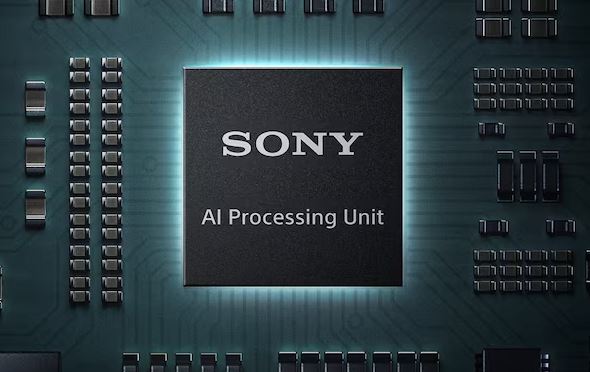
7. Dedicated AI CHIP
AI Chip The introduction of a dedicated artificial intelligence chip inside this camera has improved its overall performance significantly. Specifically, when we talk about autofocus performance, the 3D object tracking has improved greatly.
Continuous Shooting Speed The biggest improvement that we might see between these two cameras is their ability to track moving subjects while using burst mode. Both feature 10 frames per second continuous burst speed, but now the autofocus performance of the A7C Mark II camera is much improved compared to the Sony A74.
The buffer size of the Sony A74 camera remains larger, one of the biggest reasons being its ability to adopt a CF express-type card slot. The memory of the A7C Mark II camera is slightly limited to 100 frames.
8. IBIS
Image Stabilization With the introduction of the A7 Mark II camera, Sony also introduced a brand new sensor-shift image stabilization mechanism which is very helpful for photographers. Now, the overall IBIS support goes up to 7 stops, and in the Sony A74 camera, it is limited to 5.5 stops.
So if you’re a handheld photographer then undoubtedly, the A7C Mark II camera will help you a lot with its autofocus performance and ability to capture more stable images and footage.
| Sony A7C II | Sony A7 IV | |
| Internal Recording Modes | H.265/XAVC HS 4:2:2 10-Bit UHD 4K (3840 x 2160) at 23.98/50/59.94 fps [50 to 200 Mb/s] H.265/XAVC HS 4:2:0 10-Bit UHD 4K (3840 x 2160) at 23.98/50/59.94 fps [30 to 150 Mb/s] H.264/XAVC S-I 4:2:2 10-Bit UHD 4K (3840 x 2160) at 23.98/25/29.97/50/59.94 fps [240 to 600 Mb/s] 1920 x 1080p at 23.98/25/29.97/50/59.94 fps [89 to 222 Mb/s] XAVC S 4:2:2 10-Bit UHD 4K (3840 x 2160) at 23.98/25/29.97/50/59.94 fps [100 to 200 Mb/s] 1920 x 1080p at 23.98/25/29.97/50/59.94 fps [50 Mb/s] |
XAVC HS 4:2:2/4:2:0 10-Bit 3840 x 2160 at 23.98/50/59.94 fps [30 to 200 Mb/s] XAVC S 4:2:2/4:2:0 8/10-Bit 3840 x 2160 at 23.98/25/29.97/50/59.94 fps [60 to 200 Mb/s] 1920 x 1080 at 23.98/25/29.97/50/59.94/100/120 fps [16 to 100 Mb/s] XAVC S-I 4:2:2 10-Bit 3840 x 2160 at 23.98/25/29.97/50/59.94 fps [240 to 600 Mb/s] 1920 x 1080 at 23.98/25/29.97/50/59.94 fps [89 to 222 Mb/s] |
| External Recording Modes | 4:2:2 10-Bit via HDMI UHD 4K (3840 x 2160) at 23.98/25/29.97/50/59.94 fps 1920 x 1080p at 23.98/50/59.94 fps 1920 x 1080i at 50/59.94 fps 4:2:0 8-Bit via HDMI UHD 4K (3840 x 2160) at 23.98/25/29.97/50/59.94 fps 1920 x 1080p at 23.98/50/59.94 fps 1920 x 1080i at 50/59.94 fps |
4:2:2 8/10-Bit via HDMI UHD 4K (3840 x 2160) at 23.98/25/29.97/50/59.94 fps HD (1920 x 1080p) at 23.98/50/59.94 fps HD (1920 x 1080i) at 50/59.94 fps |
| AI AUTO FRAMING | Yes | NO |
| Enhanced AI AF | Yes (Dedicated AI CHIP) | NO |
| IBIS VIDEO | 7 STOPS / GYRO Support | 5.5 Stops Gyro Support |
| Gamma Curve | HDR-HLG, Sony S-Log 2, Sony S-Log 3 | S Cinetone, Sony S-Log 3 |
| Recording Limit | None | None |
| Broadcast Output | NTSC/PAL | NTSC/PAL |
| IP Streaming | MJPEG, UVC/UAC 3840 x 2160 at 12.5p, 14.99p, 25p, 30p 1920 x 1080 at 25p, 30p, 50p, 60p 1280 x 720 at 25p, 30p |
MJPEG, UVC/UAC 3840 x 2160 at 12.5p, 14.99p, 25p, 30p 1920 x 1080 at 25p, 30p, 50p, 60p 1280 x 720 at 25p, 30p |
| Built-In Microphone Type | Stereo | Stereo |
| Audio Recording | XAVC S: 2-Channel 16-Bit 48 kHz LPCM Audio MPEG4: 2-Channel AAC LC Audio |
2-Channel 16-Bit 48 kHz LPCM Audio |
9. Videographics Difference Between Both The Cameras
Resolution-wise both cameras feature exactly the same video resolution, Record in 10-bit 4:2:2 using the advanced XAVC S-I format for consistent performance and quality at bitrates up to 600 Mb/s.
With the introduction of the AI chip in Mark II camera tracking performance has improved significantly in videography. The camera is able to track moving subjects from afar and even eye detection is now much more accurate even in animals and insects while you are creating your video.
10. User Uploadable LUT and AI Framing
Other big differences like in professional cameras we have user-uploadable LUTs (Look-Up Tables). With this feature, you are able to control output in a much better way optimizing your workflow as desired.
Auto Framing With introduction of dedicated AI chip we also have an opportunity for artificial intelligent auto framing.
Enhanced Heat Sink Unit As I have said in this post, The A7C Mark II camera’s heat dissipation system is now much more improved and distributes heat effectively.
11. Price Difference vs Features Difference
If you compare the price and specifications we are getting with the Sony A7C Mark II camera it’s much more compared to the set of features that we are getting with the A74. If you want to have the same set of features with the A74 camera body you have to wait for the Sony A75 camera announcement. Otherwise, we highly recommend you get the Sony A7C Mark II camera while looking at its core specification and price ratio.
Sony A7C II Body Price $2198 B&H STORE | AMAZON.com
Sony A7 IV Body Price $2498 B&H STORE | AMAZON.com








A7C Mark II heat dissipation system is better than A7 IV?I don’t konw why A7 IV can not have User Uploadable LUT,Sony can give this function to A7 IV by firmware upgrade absolutely,but they will never do it.
In numerous tests, it I have seen that the Sony A7C II body manages to overheat more effectively when using the V60 or V90 card, as you pointed out.